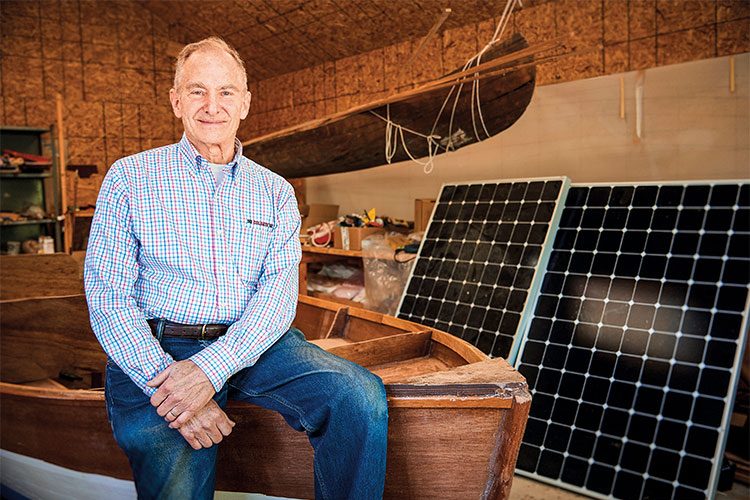David Borton ’65 doesn’t have a thermostat.
But that doesn’t mean he can’t stay warm in the winter.
Retired after 33 years of teaching physics at Rensselaer Polytechnic Institute (RPI), Borton and his wife have lived in a passive solar house, which operates completely free of any other energy source, for more than 30 years. “The house is heated by the sun. I don’t have to do anything,” he says.
Borton became hooked on solar power in the early 1970s when the energy crisis hit. He was pursuing a PhD in chemistry at RPI, and that knowledge, plus his prior PhD in physics, told him that solar energy was the way to reduce America’s dependence on oil. Since then, the Colgate physics major has championed the merits of solar living.
“It is the only energy that makes sense,” he says. The planet has an abundance of solar energy, which has the power to grow food and distill water — why not use it to generate electricity?
At his house in Troy, N.Y., Borton relies on solar panels (several of which he installed) to deliver electricity. Where the sun is positioned — overhead in the summer, farther south in the winter — determines how it hits the south-facing windows, delivering the season’s desired temperature.
“If you design the house to be energy efficient and you get the right size windows,” Borton says, “then the heat coming in can match the energy required to heat the house.” When winter arrives and the sun occasionally doesn’t shine, they burn a cord of firewood, gathered from the trees around their house. Because his electric bills are cheap, Borton saves thousands a year.
When Borton built his home in 1982, passive solar houses weren’t the norm, but as Americans seek to be more sustainable, these houses are becoming more common. The U.S. Department of Energy has a section of its website devoted to passive solar home design, and Habitat for Humanity has built more eco-friendly homes in recent years.
Borton believes everyone should move away from fossil fuels and start using solar energy — if not for the cost savings, for the good of the planet. “Not doing that isn’t shooting yourself in the foot; it’s shooting yourself in the head,” he says. “You can’t deny climate change if you understand physics of the atmosphere.”
Retirement has given Borton an excuse to focus on his solar ventures, and his current one isn’t restricted to land.
Borton has been around boats since before he was able to walk, exploring upstate New York in canoes and Adirondack guide boats. Fast forward a few decades, when his Grumman aluminum canoe became tarnished from sitting in the woods. Using his physics know-how, he upgraded it with two solar panels, plus a battery and motor to make a moving boat that requires no gasoline.
Because his experiment was so successful (it was built 15 years ago and is still in operation), he made more, completing a 40-foot boat in 2015. Using a silicon crystal in its solar panel, light converts into electricity, powering the boat. It can hold up to 12 tons of cargo, and its first voyage transported bales of cardboard down the Erie Canal to be recycled.
Borton’s most recent solar-electric boat is 44 feet long and is in the process of being certified by the United States Coast Guard. It is now owned by the Hudson River Maritime Museum in Kingston, N.Y., and will start taking passengers on tours along the Hudson River this summer.

